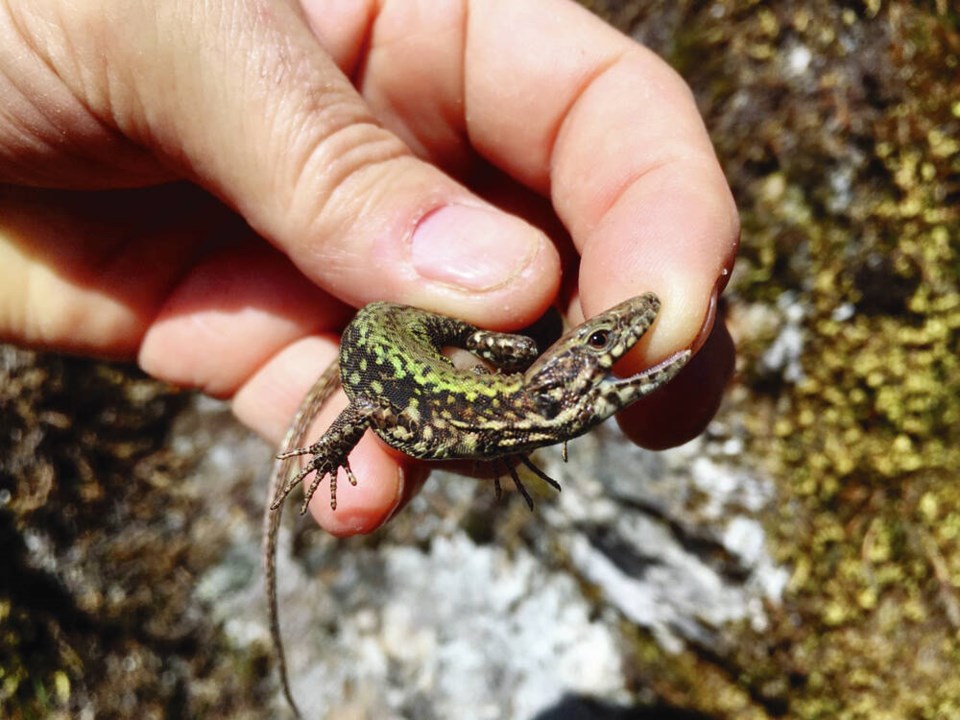I stepped on a lizard the other day.
I didn’t mean to. It ran across my path as my foot was coming down, and it was a choice between saving the lizard or my ankle.
I chose my ankle.
As has been reported in these pages, European or common wall lizards are overrunning the region. Since about a dozen lizards were released from a small zoo near Butchart Gardens in the late 1960s, their descendants have colonized the Island’s east coast, from Victoria to Campbell River. The Island’s wall lizard population is now estimated to be in the 500,000–700,000 range.
They’ve also been reported on Denman, Salt Spring and Pender islands, and in Abbotsford, West Vancouver and Osoyoos on the mainland.
Now, if I’d caught just the tail with my boot last week, the lizard would probably have survived. The tail would have detached, and the lizard would run free, possibly living long enough to grow another tail.
Nature Boy and I witnessed the tail-dropping phenomenon several years ago when we were travelling in southern Europe, the common wall lizard’s home and native land. A lizard had found its way around the window screen into the room we were renting, and, in our attempts to trap it with a wastepaper basket to eject it from the premises, we caught the tail with the edge of the basket.
As the lizard ran, the lizard-less tail continued to thrash, and Nature Boy practically levitated in excitement. “That is so cool,” he squealed.
I, on the other hand, almost lost my morning café crème.
Last week’s encounter was less gross than that earlier experience and also less gross than it sounds. Despite the whole-body squash, I felt nothing through the sole of my boot. The lizard was not much longer than two centimetres. With its internal skeleton somewhat padded by soft tissues, less of a crunch occurred than if the creature had been, for example, a staghorn beetle of similar size. A big beetle’s exoskeleton would generate quite a snap and crackle.
I suspect the lizard’s youth and inexperience with clumsy-footed humans contributed to its demise. Moving towards danger is not usually the best escape route. Indeed, the dozens of other, larger lizards that had been sunning themselves on the walkway alongside the little lizard had all zipped into the nearest grass and bushes alongside as we approached — one moment practically covering the sidewalk, the next moment gone.
That said, wall lizards eat their own young. Perhaps the youngster saw its options as being a choice between taking its chances with a boot or being eaten alive by its cousins. Death by boot at least would be instant.
Little is known how the now-too-common common wall lizard may be harming the Island’s environment, but some evidence suggests wall lizards are eating pollinating bees and dining on young garter snakes. A decade ago, Nature Boy and I would see the occasional garter snake in our yard. Since the invasion of the wall lizards, we’ve seen no snakes.
If they’re preying on garter snakes, the lizards likely also are preying on native, endangered sharp-tailed snakes and native northern alligator lizards. If nothing else, they’re competing with the native, bug-eating reptiles for nesting sites and food.
According to a recent study published in the journal Scientific Reports, invasive reptiles and amphibians cost the global economy more than $17 billion US between 1986 and 2020. The Island doesn’t yet have brown tree snakes — the world’s most expensive invasive reptile — but other invasive reptile species in the area include the red-eared slider turtle and, of course, the wall lizard, which are far too common here now.
“Don’t feel bad,” Nature Boy said last week as we peered down at the tiny-lizard pancake. “Because of your stompin’ clompen, one less wall lizard will grow up and produce more wall lizards. And some bird will enjoy what’s left of this one as a snack.”
“Or a rat will. Or a cat. Or another wall lizard,” I answered.
>>> To comment on this article, write a letter to the editor: [email protected]



